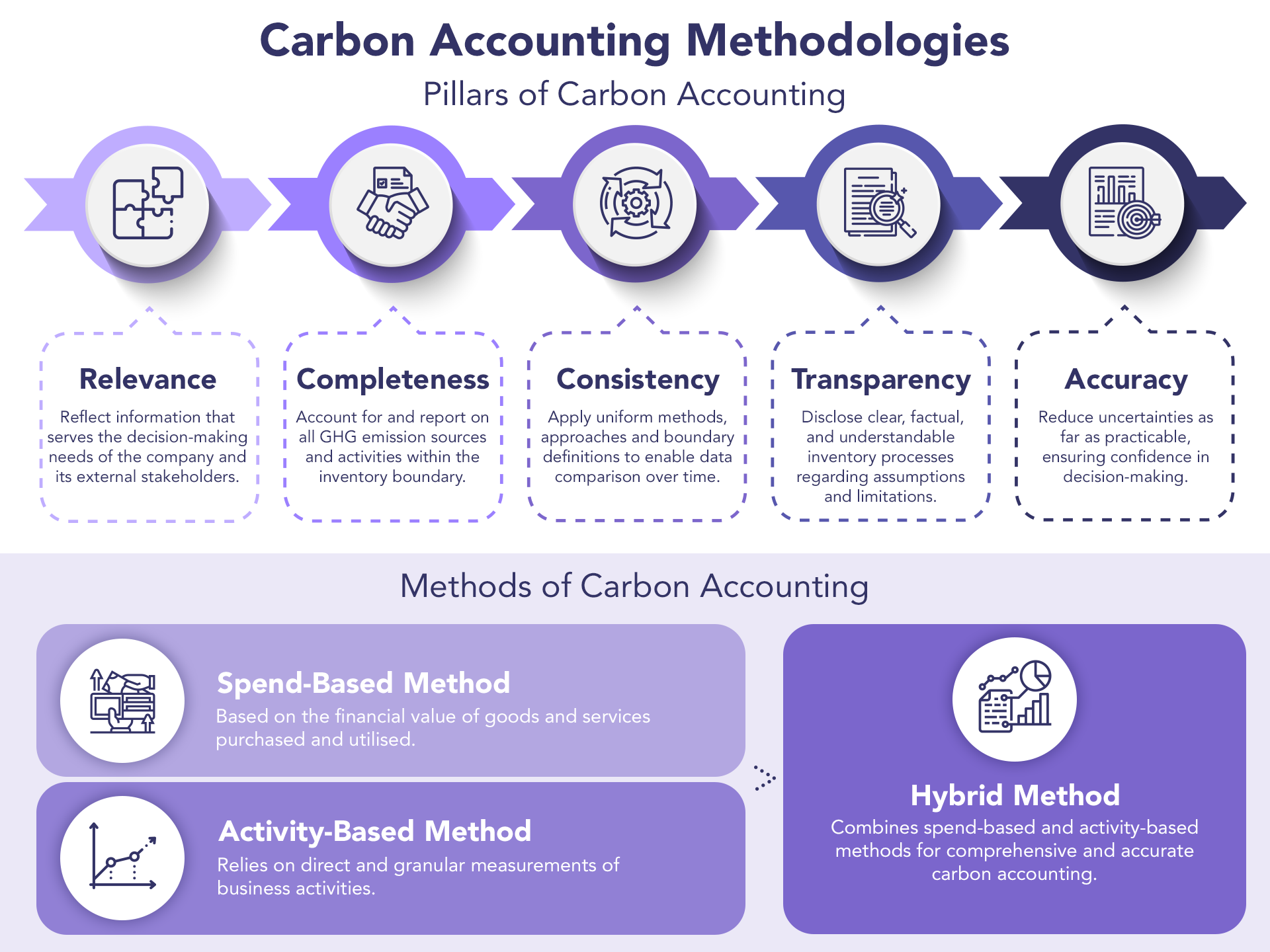Summary
- Carbon accounting enables businesses to track greenhouse gas emissions, identify hotspots, evaluate climate actions, and set reduction targets.
- The carbon accounting process comprises data management, measurement across three emission scopes, and reporting; adherence to the GHG Protocol's five principles ensures accurate and transparent emissions reporting.
- Various methodologies, including spend-based and activity-based approaches, provide tailored insights for organizations, while tools and platforms like Terrascope simplify data collection and reporting, facilitating effective carbon management strategies.
This blog explores the diverse carbon accounting methodologies and tools used to quantify emissions, and highlights their significance in promoting sustainable practices. By understanding the appropriate use cases of these methodologies and tools, businesses can make informed decisions on their Net Zero commitments and their reporting actions towards complying with regulations.
Overview of carbon accounting
Carbon accounting involves quantifying an organisation's greenhouse gas (GHG) emissions, measured in a standard unit called CO2e (carbon dioxide equivalent) - a unified way to express the contribution of each GHG to climate change. The goal of carbon accounting is to determine an organisation's carbon footprint, which reflects its contribution to climate change and can drive climate action. This is done by identifying emission sources, matching data with appropriate factors, and categorising emissions into three scopes. There are three key steps in the carbon accounting process -
- Data management: Business data is collected and processed across various sources, after which it is matched to the appropriate emission factors that specify the associated estimated amount of greenhouse gas emissions involved.
- Measurement: The data is broken down and measured in three scopes defined by the GHG protocol. While control over Scopes 1 and 2 is easier, measuring Scope 3 emissions involves various methodologies that companies can utilise.
- Reporting: The final step in the carbon accounting process is reporting and verifying data through different frameworks.
The pillars of carbon accounting methodologies
Carbon accounting adheres to five fundamental pillars outlined by the GHG Protocol. These principles ensure the accuracy, relevance, and transparency of GHG reporting, aiding decision-making for both internal and external stakeholders. The five principles are as follows-
- Relevance: Companies must gauge relevance when deciding what activities to include within their inventory boundaries. They should also make certain that data sources align with the company's goals, ensuring the inventory accurately mirrors emissions and meets the decision-making needs of internal and external stakeholders.
- Completeness: The Scope 3 emissions inventory should aptly represent a company's GHG emissions and cater to users' decision-making needs. However, even in data-constrained scenarios, excluding activities that compromise relevance is discouraged. Additionally, any exclusions must be documented and justified transparently.
- Consistency: This means applying uniform accounting methods, boundary definitions, and calculation methodologies, which ensures reliable data for comparison over time. The GHG Protocol also states that any changes to the inventory boundary need to be transparently documented and justified, and may warrant recalculation of base year emissions.
- Transparency: Clear, factual, and understandable disclosure of GHG inventory processes, assumptions, and limitations is paramount. Information should be recorded, compiled, and analysed in a way that allows internal reviewers and external assurance providers to attest to its credibility and allows external parties to replicate results.
- Accuracy: Data accuracy instils confidence in users' decisions. Precise estimation is pivotal to informing decisions and aligning inventory relevance. Data should accurately reflect emissions without systematic overestimation or underestimation. Companies should reduce uncertainties in the quantification process as far as practicable and ensure their own data is sufficiently accurate to serve their decision-making needs.
Embracing these pillars elevates the credibility and utility of carbon accounting efforts. As companies and countries navigate the climate crisis, aligning with these pillars paves the way toward robust and impactful climate action.

What are the different methods of carbon accounting?
Carbon accounting generally involves three main approaches to quantify emissions: Spend-based, Activity-based or Hybrid methodology that combines both.
The choice of method depends on factors such as the organisation's goals, data availability, and the level of accuracy required. Selecting the appropriate methodology hinges on the company’s priorities: A large-scale retailer with complex supply chains might find the spend-based method advantageous, while a manufacturing plant might opt for activity-based approaches to accurately measure its production emissions.
In all cases, the chosen methodology should align with the organisation's objectives and ensure accurate emission quantification. Here are the three main methods used in carbon accounting -
Spend-Based Method:
a) What is it?
The spend-based carbon accounting approach estimates a company's indirect emissions by evaluating the value of goods and services it purchases.
b) How does it work?
This involves identifying relevant GHG categories within Scope 3 emissions, calculating the economic value of acquired goods, and then multiplying it by secondary data like industry averages and emission factors. These emission factors are typically based on industry benchmarks or other sources of emissions data, such as published databases and government statistics, and provide an estimate of Scope 3 emissions.
c) Advantages
The spend-based carbon accounting method offers a convenient and economical path for companies, regardless of size, to gauge their indirect emissions.
d) Disadvantages
It is important to note that the data obtained might lack accuracy due to its dependence on estimates and average emission factors.
Activity-Based Method:
a) What is it?
The activity-based approach to carbon accounting measures activities like procurement, transportation, and product use.
b) How does it work?
It involves collecting raw data on all business activities in a company’s value chain and multiplying it by appropriate emission factors.
c) Advantages
This method enables enterprises to track emissions from all parts of their supply chains and calculate a comprehensive metric of their Scope 3 emissions. This can lead to more targeted and effective emissions reduction strategies.
d) Disadvantages
Challenges include the intricacy and resource-intensiveness of procuring data based on activities, especially for larger businesses. Relying on secondary data and industry standards can lead to data gaps and inaccuracies, which can result in inaccurate carbon accounting. To gain a comprehensive view, companies often integrate this approach with others, such as spend or activity-based methods.
Hybrid Method:
a) What is it?
A holistic approach that merges various methodologies, pivotal for addressing a wider emissions spectrum. The hybrid model methodology is recommended by the Greenhouse Gas Protocol, and it is the most widely used carbon calculation standard.
b) How does it work?
It involves using all of the activity-based data possible and then using spend-based methods to estimate the rest.
c) Advantages
By integrating the best aspects of both the activity-based and spend-based methods, and leveraging data accessibility, enterprises can strike a balance between accuracy and feasibility in quantifying their emissions. This holistic strategy equips businesses with comprehensive insights, facilitating the formulation of well-informed carbon management strategies that align with emission reduction goals.
d) Disadvantages
Implementing this method demands greater intricacy and time investment compared to a single method. Acquiring detailed activity-based data also presents challenges, particularly with third-party vendors or proprietary data. These hurdles can result in data collection gaps and inaccurate carbon accounting.
What other Carbon Accounting Tools Can Be Utilised?
The GHG Protocol explains these various tools of carbon accounting in its Corporate Accounting and Reporting Standard, and has also built four different types of tools for companies -
- Cross-sector tools: Applicable to many industries and businesses regardless of sector.
- Country-specific tools: Customised for particular developing countries.
- Sector-specific tools: Principally designed for the specific sector or industry listed, though they may apply to other situations.
- Tools for countries and cities: These tools help countries and cities track progress toward their climate goals.
These tools ensure a tailored and precise approach to carbon accounting, enabling more targeted and effective emission reduction strategies. They are particularly valuable for industries facing unique emission challenges or those operating in countries with distinct regulatory environments. These tools address sector-specific complexities, regional emission factors, and national policy frameworks.
Where Terrascope comes in
Terrascope’s end-to-end decarbonisation platform can play a vital role in simplifying the carbon accounting process for businesses. Through machine learning, advanced data analytics and reporting tools, Terrascope can streamline data collection, analysis, and reporting, ensuring accurate and transparent carbon accounting down the line that aligns with the pillars of carbon accounting methodologies. Our platform is a powerful tool that can empower companies in:
- Data management: Terrascope provides companies with valuable insights into their emission hotspots and offers a 5x faster data ingestion process than manual efforts which allows businesses to focus on strategic decisions.
- Measurement: Terrascope breaks down complex supply chains, products, and packaging into their individual components, and matches the most accurate emissions factors for each constituent. The platform is able to measure emissions with 92% accuracy, offering businesses an opportunity to build operational resilience.
- Reporting: The platform empowers businesses to create and export reports in their desired formats, and seamlessly integrates with various reporting platforms through API integrations. Terrascope's user-friendly interface enables businesses to establish baselines, monitor progress, make informed decisions, and implement targeted climate actions.
Carbon accounting plays a vital role in addressing the urgent challenge of climate change. By employing diverse carbon accounting methodologies, organisations can gain comprehensive insights into their carbon impact and develop effective mitigation strategies.
In the collective effort to combat climate change, carbon accounting remains an indispensable tool to pave the way for a greener and more sustainable future. With proactive measures and collaborative efforts, we can work towards a world where carbon emissions are mitigated, and the impacts of climate change are minimised for generations to come.
FAQs
1. Why is carbon accounting important?
Carbon accounting is essential as it allows businesses to quantify their greenhouse gas emissions accurately. Understanding the carbon footprint helps identify emission sources, set reduction targets, and adopt sustainable practices to combat climate change effectively.
2. How can I measure carbon emissions for my business?
To measure carbon emissions for your business, you can employ various methods, including collecting activity data and using emission factors, conducting carbon footprint assessments, and implementing Life Cycle Assessments (LCA). Collaborating with sustainability experts and using standardised methodologies can ensure accurate measurement and reporting.
3. What are the benefits of tracking Scope 3 emissions?
Tracking Scope 3 emissions is crucial for a comprehensive understanding of a business’ environmental impact. It allows businesses to assess emissions throughout their value chain, engage with suppliers and customers, and identify opportunities for emission reduction collaboration.
4. How can carbon intensity metrics inform policy decisions?
Carbon intensity metrics, such as emissions per unit of GDP or energy consumed, provide valuable insights into the environmental efficiency of economic activities. Policymakers can use this data to shape climate policies, prioritise clean energy solutions, and drive sustainable economic growth.
5. What role does Terrascope play in carbon accounting?
Terrascope uses advanced data analytics and satellite technology to offer real-time and high-resolution insights into greenhouse gas emissions. It empowers stakeholders with accurate and up-to-date emission data, aiding informed decision-making and targeted climate actions on a global scale.



